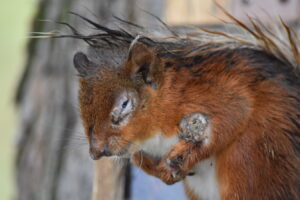The Squirrel Pox Virus Disease is usually fatal to red squirrels. Grey squirrels are carriers of the infection and can spread the disease to red squirrels. Greys have developed immunity to the disease having been exposed to the virus for many years.
In sharp contrast, the mortality rate for untreated infected red squirrels in the wild appears to be 100%, most dying within 15 days of being infected.
Transmission
The virus can spread through contact with the infected lesions or contaminated crusts. Most pox viruses are highly resistant to drying, which allows crusts to remain infectious for long periods of time. It is believed that the virus may be transferred by feeders, traps or any other equipment used in areas occupied by squirrels which is why red squirrel preservation organisations recommend that all equipment is disinfected regularly.

Symptoms
In red squirrels, the virus causes skin ulcers, lesions, and scabs. It can also cause swelling and discharge (from the lesions/scabs) near the eyes, mouth, feet, and genitalia. Additionally, squirrels that fall victim to the disease often become increasingly lethargic as it progresses. Infected animals are said to resemble rabbits with myxomatosis, in that they are sometimes found shivering and lethargic. Death normally follows and is a long and painful experience.
Origins
The origins of the squirrel pox virus disease are mostly unknown. The first confirmed incident was in East Anglia in the 1980s. It has since spread to Lancashire (confirmed in 1995-1996), Cumbria (spring 1998), Durham (1999), and Northumberland (1999). The squirrel pox virus is regarded as a significant factor in the decline of red squirrel populations in the UK.
Further information
Red Squirrels Northern England have produced two downloadable advice notes: Squirrel Pox Virus 2021>> and Advice Note To Vets>>



